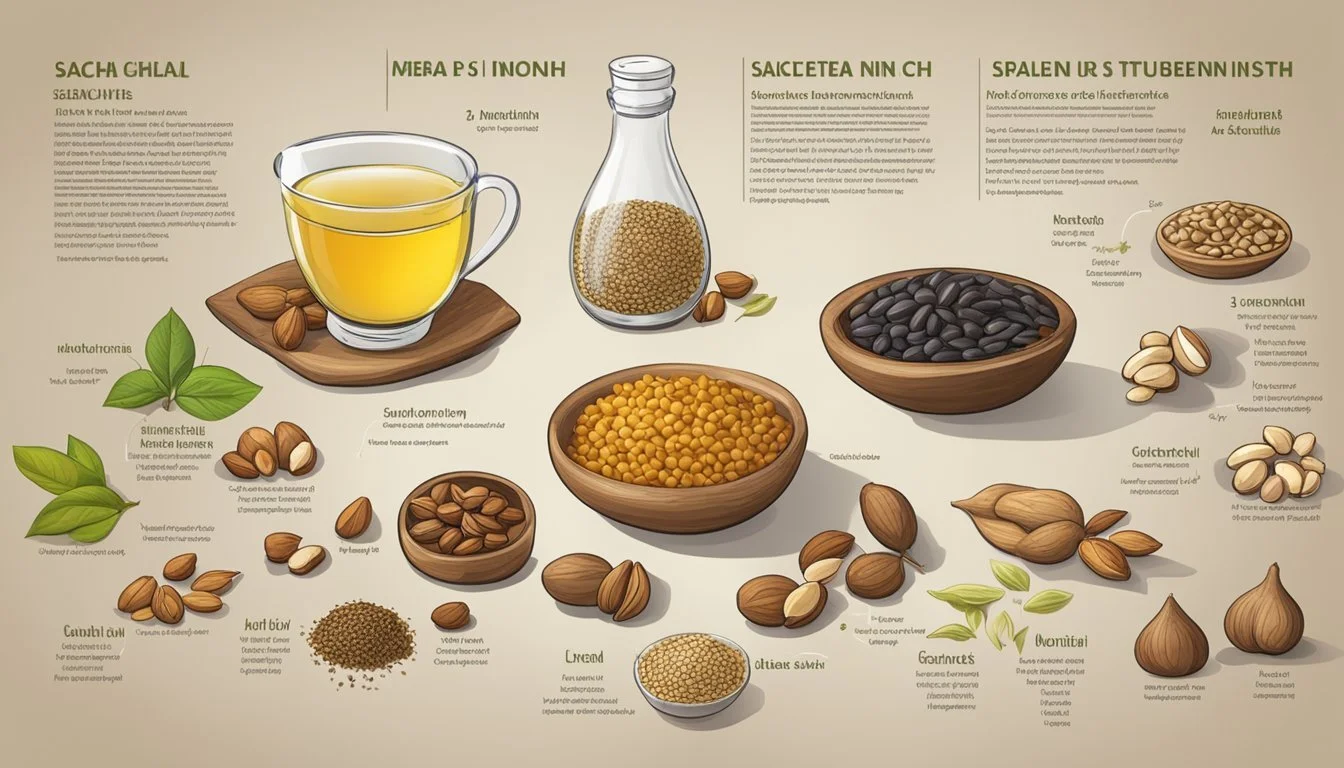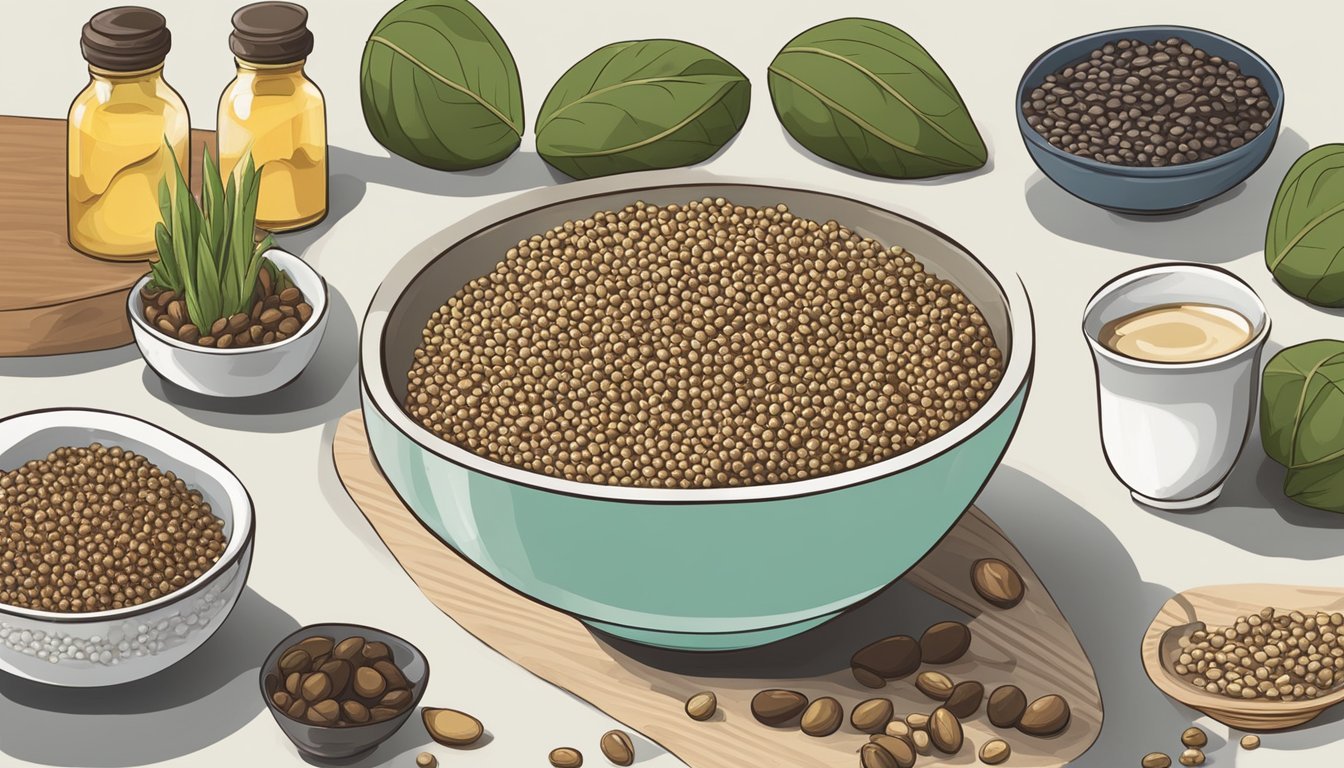Sacha Inchi Substitutes
Top Alternatives for Allergy-Safe Cooking
Sacha inchi, often referred to as the Inca peanut, is a plant native to South America and thrives in the Amazon rainforest. Recognized as a superfood, it is highly esteemed for its nutrient-rich seeds, which boast a comprehensive profile of omega fatty acids, proteins, and antioxidants. Due to its health benefits, sacha inchi has gained popularity worldwide, especially among individuals seeking plant-based nutritional sources.
Despite its growing popularity, some may find the need to seek substitutes for sacha inchi, whether due to availability issues, dietary preferences, or allergy constraints. Alternatives that provide comparable health benefits and nutritional values are sought after to maintain a balanced intake of essential fats and proteins. The quest for substitutes also reflects the diverse culinary applications of sacha inchi, ranging from direct consumption of the seeds to the use of sacha inchi oil in various dishes.
Sourcing sacha inchi outside of South America, particularly from places like Peru where it is widely cultivated, can be a challenge. Consequently, alternatives can be crucial for global consumers aiming to integrate similar nutritional profiles into their diets. Substitutes not only serve as a practical solution but also open the door for variability in nutrient sources, supporting a well-rounded and diversified dietary regimen.
Nutritional Profile of Sacha Inchi
Sacha Inchi seeds, derived from the Plukenetia volubilis plant, are acclaimed for their impressive nutrient composition. These seeds are particularly noted for their high protein content, with approximately 7.3 grams per ounce and 26 grams per 100 grams of product. They offer a complete protein, containing all nine essential amino acids necessary for human health.
The oil extracted from Sacha Inchi is rich in unsaturated fatty acids, predominantly omega-3 and omega-6 fatty acids, with a composition that favors a heart-healthy balance. This high concentration of omega-3 fatty acids sets it apart from other plant-based oils, making it a premium choice for supporting cardiovascular health.
Micronutrients such as Vitamin E are also abundant in Sacha Inchi, providing additional antioxidant properties. The seeds are not only high in macronutrients like protein and healthy fats but also contain beneficial fiber, which aids digestion.
Here is a summary of its nutritional values:
Protein: High-quality, plant-based protein
Fatty Acids: Rich in omega-3 (alpha-linolenic acid) and omega-6 (linoleic acid)
Fiber: Supports digestive health
Vitamin E: an antioxidant that protects cells from oxidative stress
Micronutrients: Contains other vitamins and minerals
Calories: Energy-providing but with a low proportion of carbohydrates
The fat in Sacha Inchi is predominantly unsaturated, with a small amount of saturated fat. The seed's oil content is recognized for its potential to positively influence lipid profiles. A single ounce of Sacha Inchi seeds not only nourishes the body with vital amino acids and fatty acids but also provides a nutrient-dense snack or dietary supplement.
Health Benefits and Uses
Sacha Inchi is a potent source of nutrients, conferring various health benefits primarily due to its high content of omega-3 fatty acids, healthy fats, and fiber. These components make it an ideal ingredient not only for maintaining general well-being but also for specific health-related applications.
Cardiovascular Health
Sacha Inchi seeds are known to be rich in omega-3 fatty acids, which play a significant role in cardiovascular health. Consuming these fatty acids can help lower triglycerides and bad LDL cholesterol levels, while potentially boosting good HDL cholesterol. Regular intake could lead to better regulation of blood pressure and a lowered risk of heart disease.
Gut and Digestive Health
The high fiber content in Sacha Inchi aids in promoting digestive health. Fiber helps to support the growth of beneficial bacteria in the gut, crucial for a balanced microbiome. Consequently, this can enhance nutrient absorption and improve overall gut health.
Skin and Hair Care
Sacha Inchi oil is used in various skin care products due to its hydrating properties. It contains omega-3 fatty acids that can be easily absorbed through the skin, promoting a more radiant complexion and softer skin. Additionally, it is employed in hair care to nourish and strengthen the scalp and hair strands.
Anti-inflammatory Properties
Antioxidants present in Sacha Inchi help to reduce inflammation typically associated with chronic diseases. Its anti-inflammatory capabilities are specifically beneficial in managing conditions that lead to inflammation, supporting overall health and well-being.
Weight and Appetite Management
Intake of Sacha Inchi seeds may facilitate weight loss and appetite control. The presence of healthy fats and fiber in the seeds contributes to a feeling of fullness, which can help in reducing overall calorie intake and aid in weight management efforts.
Culinary Uses
Sacha Inchi's versatility in the kitchen is due largely to its nutty flavor and high protein content. Its various forms, including seeds, oil, and powder, add nutritional value to a wide range of dishes.
Cooking and Baking
Sacha Inchi seeds provide a crunchy texture and protein boost to baked goods such as cookies, muffins, and bread. In their oil form, they serve as a healthy fat source, ideal for sautéing or dressing recipes that require a mild, nutty essence.
Seeds: Add to granola, bread, or as a topping on baked goods.
Oil: Use as a substitute for other oils in cooking and baked goods.
Protein Powder/Flour: Incorporate into recipes for a protein enhancement.
Smoothies and Beverages
For a nutritional punch, Sacha Inchi protein powder blends seamlessly into smoothies and shakes, providing essential fatty acids without altering the flavor significantly.
Seeds: Soak in water and blend into a nutritious drink.
Protein Powder: Mix into smoothies for added protein and fatty acids.
Butter: Include in beverage recipes for smoothness and flavor.
Salads and Dressings
Sacha Inchi oil is a superb dressing base, imparting a distinctive, nutty flavor to salads. Its edible seeds serve as a crunchy garnish, while the oil can be drizzled atop dishes as a finishing touch.
Oil: Drizzle over greens or whisk into salad dressings.
Seeds: Sprinkle as a topping on salads for extra texture.
Protein Powder: Blend into dressings for a nutrient-dense concoction.
Sacha Inchi Forms and Variants
Sacha Inchi, a plant renowned for its nutrient-rich seeds, is available in several forms suitable for diverse dietary requirements and uses, ranging from cooking to skin care. Each variant possesses unique qualities, catering to specific preferences and nutritional profiles, including high protein and fiber content.
Oil
Sacha Inchi oil is extracted from the seeds of the plant and is celebrated for its high unsaturated fat content. It contains omega-3, omega-6, and omega-9 fatty acids, which are beneficial for heart health. With a mild, nutty flavor, the oil is ideal for salad dressings or a finishing oil for dishes, though it's not recommended for high-heat cooking. In skin care, the oil is known for its hydrating properties and can be found in organic and cosmetic products.
Seeds and Nuts
Sacha Inchi seeds are enjoyed both raw and roasted, often heralded as a superfood snack due to their impressive nutritional profile. A single serving provides around 70 calories, 3 grams of plant-based protein, and 5 grams of fat. They are also an excellent source of fiber. The seeds can be consumed directly, added to trail mixes, or used as a crunchy topping for salads and other dishes.
Powder and Flour
Sacha Inchi is also available in powder and flour forms, making it a versatile component for plant-based protein powders. The fine powder is rich in protein and fiber, making it a nutritious addition to shakes, smoothies, and baked goods. Sacha Inchi protein powder provides a high-quality, organic protein boost, especially beneficial for those following a vegetarian or vegan diet.
Comparison to Other Superfoods
In evaluating Sacha Inchi as a superfood, one may consider its nutritional content, culinary applications, and market factors in relation to other superfoods such as chia seeds, flaxseeds, and hemp seeds.
Nutritional Comparison
Sacha Inchi seeds, harvested in Peru and other regions of South America, are dense with nutrients, particularly omega-3 fatty acids. These seeds outpace many alternatives with substantial levels of protein and fiber.
Chia Seeds: A strong alternative, with a balanced mix of omega-3, omega-6 fatty acids, and fiber, but lower in protein.
Flaxseeds: Similar to Sacha Inchi, they are high in ALA (alpha-linolenic acid), yet offer less protein.
Hemp Seeds: Although a good source of protein and omega fatty acids, they still fall short of the omega-3 levels found in Sacha Inchi.
Superfood Omega-3 Protein Fiber Sacha Inchi High High Moderate Chia Seeds Moderate Moderate High Flaxseeds High Moderate Moderate Hemp Seeds Moderate High Moderate
Taste and Culinary Versatility
Sacha Inchi seeds carry a unique flavor that is mildly nutty and earthy, enhancing their versatility in various recipes. Their taste is distinct from the more neutral-flavored chia or the slightly nuttier flaxseed.
Able to be used in both sweet and savory dishes, similar to techniques employed across the Caribbean for versatile foods like coconut oil.
They can be consumed raw or roasted, incorporated into smoothies, or used as a plant-based protein in organic culinary creations.
Availability and Cost
Sacha Inchi seeds are not as widely available as other superfood seeds, which can influence both cost and accessibility.
In comparison to more ubiquitous seeds like sunflower or peanuts, Sacha Inchi generally commands a higher price, due in part to their exotic origin and smaller production scale.
While seeds like chia and flaxseeds have become mainstream globally, Sacha Inchi is relatively new outside of South America and may require one to seek out specialty or health food stores.
Potential Side Effects and Considerations
When incorporating Sacha Inchi into the diet, consumers should be aware of its potential side effects and considerations to ensure its safe consumption.
Side Effects: While Sacha Inchi is generally considered safe, there are some reported side effects. Some individuals may experience:
Nausea: A possible reaction which could be attributed to the high-fat content or to individual sensitivity.
Allergic Reactions: As with any nut or seed, allergic reactions are possible, with symptoms ranging from mild to severe.
Antinutrients: Like many seeds and nuts, Sacha Inchi might contain antinutrients which can interfere with the absorption of certain minerals.
Alkaloids: Presence of these naturally occurring compounds is typical in seeds; however, they can cause negative effects if consumed in large quantities.
Consumers should moderate their intake and consider the following to minimize risks:
Gradual Introduction: Start with small amounts to assess personal tolerance.
Quality Source: Obtain Sacha Inchi from reputable sources to ensure purity and quality.
To conclude, Sacha Inchi seeds and oil can be a healthy addition to one's diet, but as with any food product, individuals should consume them mindfully and be cognizant of their body’s reactions to its introduction.
Sourcing and Sustainability
As Sacha Inchi gains popularity for its health benefits, understanding the nuances of its sourcing and sustainability is essential. The cultivation and processing of this crop carry implications for both local communities and the environment.
Ethical Sourcing
Sacha Inchi is primarily cultivated in South America, with Peru taking the lead in production. Farmers in the Amazon rainforest and other regions of Peru often engage in ethical sourcing practices. These include fair trade initiatives and supporting small-scale producers. Efforts to ensure a sustainable and ethical supply chain also include collaboration with indigenous farmers, which promotes economic growth within local communities.
Environmental Impact
The effect of Sacha Inchi cultivation on the environment is assessed through the lens of sustainability. In regions like the Peruvian Amazon, the adoption of sustainable agricultural practices has been encouraged to minimize deforestation and preserve biodiversity. Organic farming methods are employed to reduce the impact of chemical fertilizers on both the land and the resultant Sacha Inchi oil and seeds.
Storage and Shelf Life
The storage of Sacha Inchi products, including the oil and seeds, is vital for maintaining their nutritional integrity. Proper storage conditions, such as cool and dry environments, can help extend the shelf life. For Sacha Inchi oil, it is important to store it in dark bottles away from direct sunlight to prevent oxidation. Generally, the shelf life of the oil is up to two years when stored correctly, while the seeds can last several months if kept in airtight containers.
Incorporating Sacha Inchi into Your Diet
Sacha Inchi is recognized for its nutrient-dense profile, providing essential omega-3 fatty acids, high-quality plant-based protein, and a diverse array of vitamins and minerals. This makes it an advantageous addition to a variety of meals and diets, particularly for those seeking healthy fats and plant-based protein options.
Meal Ideas
Breakfast
Oatmeal: Mix ground Sacha Inchi seeds into your morning oatmeal for a boost of protein and omega-3.
Smoothies: Add Sacha Inchi powder for a nutty flavor and a surge of essential fatty acids.
Lunch and Dinner
Salad: Top green salads with Sacha Inchi seeds for a satisfying crunch and nutritional enhancement.
Main Courses: Incorporate Sacha Inchi oil as a dressing or include seeds as a garnish on plant-based dishes for a dose of healthy fats.
Plant-Based Diet Integration
Vegan Nutrition: Sacha Inchi is a superfood that complements vegan diets by providing all nine essential amino acids, making it an excellent source of complete protein.
Integration Tips:
When preparing plant-based meals, use Sacha Inchi seeds or oil to enrich the dish with omega-3 fatty acids, critical for heart and brain health.
Sacha Inchi can be easily introduced into vegan smoothies and snacks, contributing to a balanced and nutrient-rich plant-based diet.








